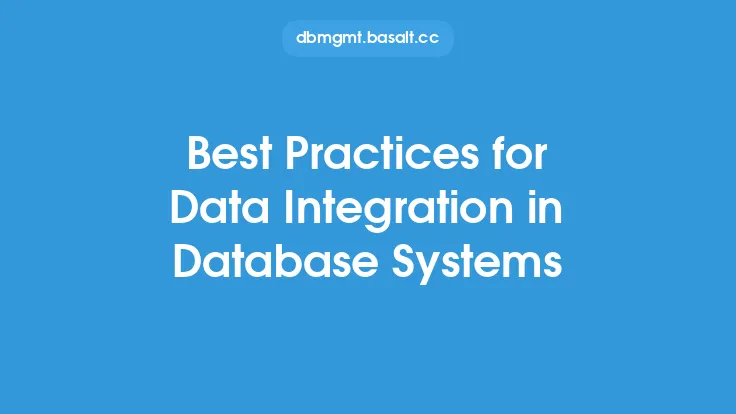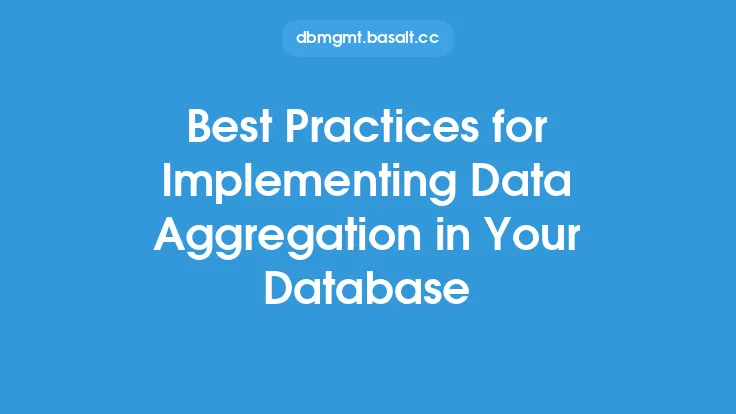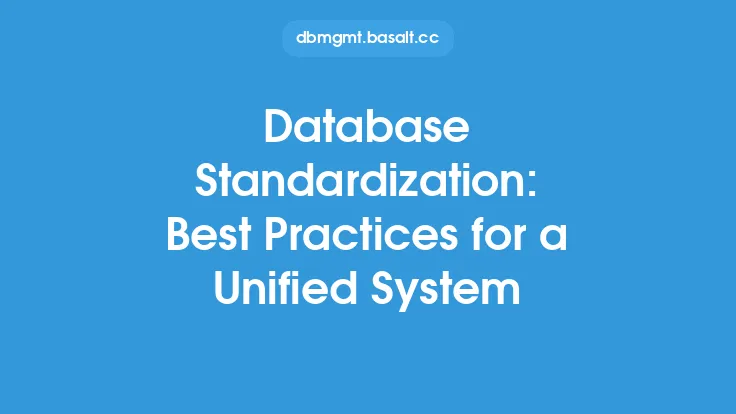Effective database security is crucial for any organization that handles sensitive data, and governance plays a critical role in ensuring the confidentiality, integrity, and availability of this data. Governance best practices for database security involve a set of principles, policies, and procedures that guide the management and protection of databases. In this article, we will explore the key governance best practices for database security that organizations can implement to protect their databases from unauthorized access, data breaches, and other security threats.
Introduction to Database Governance
Database governance refers to the overall management and oversight of an organization's databases, including the people, processes, and technology involved in managing and protecting these databases. Effective database governance involves establishing clear policies, procedures, and standards for database management, security, and compliance. It also involves ensuring that databases are properly configured, monitored, and maintained to prevent security breaches and data losses. Database governance is essential for ensuring that databases are aligned with the organization's overall security strategy and compliance requirements.
Establishing a Database Security Governance Framework
A database security governance framework provides a structured approach to managing and protecting databases. This framework should include the following components:
- Policies: Clear and concise policies that outline the organization's database security requirements, including access controls, authentication, and authorization.
- Procedures: Standard operating procedures (SOPs) that outline the steps to be taken in managing and protecting databases, including backup and recovery, patch management, and vulnerability assessment.
- Standards: Technical standards that outline the requirements for database configuration, security, and compliance, including encryption, firewalls, and access controls.
- Guidelines: Guidelines that provide additional guidance and best practices for database security, including secure coding practices, secure data storage, and secure data transmission.
- Metrics: Key performance indicators (KPIs) and metrics that measure the effectiveness of the database security governance framework, including metrics for security incidents, compliance, and risk management.
Database Security Roles and Responsibilities
Clear roles and responsibilities are essential for effective database security governance. The following roles and responsibilities should be established:
- Database Administrator (DBA): The DBA is responsible for the day-to-day management of databases, including configuration, maintenance, and troubleshooting.
- Database Security Officer (DSO): The DSO is responsible for ensuring the security and compliance of databases, including access controls, authentication, and authorization.
- Compliance Officer: The compliance officer is responsible for ensuring that databases are compliant with relevant laws, regulations, and standards, including data protection laws and industry standards.
- Incident Response Team: The incident response team is responsible for responding to security incidents, including data breaches and unauthorized access.
Database Access Controls and Authentication
Database access controls and authentication are critical components of database security governance. The following best practices should be implemented:
- Least Privilege Access: Access to databases should be granted on a least privilege basis, with users only having access to the data and resources they need to perform their jobs.
- Multi-Factor Authentication: Multi-factor authentication should be implemented to ensure that only authorized users have access to databases.
- Role-Based Access Control: Role-based access control should be implemented to ensure that users only have access to the data and resources that are relevant to their roles.
- Password Management: Passwords should be managed effectively, including password rotation, password expiration, and password strength requirements.
Database Encryption and Masking
Database encryption and masking are essential for protecting sensitive data. The following best practices should be implemented:
- Data-at-Rest Encryption: Data-at-rest encryption should be implemented to protect sensitive data stored in databases.
- Data-in-Transit Encryption: Data-in-transit encryption should be implemented to protect sensitive data transmitted between databases and applications.
- Data Masking: Data masking should be implemented to protect sensitive data from unauthorized access, including masking of sensitive data in development and testing environments.
Database Monitoring and Auditing
Database monitoring and auditing are critical components of database security governance. The following best practices should be implemented:
- Real-Time Monitoring: Real-time monitoring should be implemented to detect and respond to security incidents, including unauthorized access and data breaches.
- Audit Logging: Audit logging should be implemented to track and record all database activity, including access, modifications, and deletions.
- Vulnerability Assessment: Vulnerability assessment should be implemented to identify and remediate vulnerabilities in databases and related systems.
Database Backup and Recovery
Database backup and recovery are essential for ensuring the availability and integrity of databases. The following best practices should be implemented:
- Regular Backups: Regular backups should be performed to ensure that databases can be recovered in the event of a disaster or data loss.
- Backup Validation: Backup validation should be performed to ensure that backups are complete and can be recovered successfully.
- Disaster Recovery Planning: Disaster recovery planning should be implemented to ensure that databases can be recovered quickly and efficiently in the event of a disaster.
Conclusion
In conclusion, governance best practices for database security are essential for protecting sensitive data and ensuring the confidentiality, integrity, and availability of databases. By establishing a database security governance framework, defining clear roles and responsibilities, implementing database access controls and authentication, encrypting and masking sensitive data, monitoring and auditing databases, and performing regular backups and recovery, organizations can ensure the security and compliance of their databases. Effective database security governance requires a structured approach, clear policies and procedures, and ongoing monitoring and improvement. By following these best practices, organizations can protect their databases from unauthorized access, data breaches, and other security threats, and ensure the trust and confidence of their customers and stakeholders.





